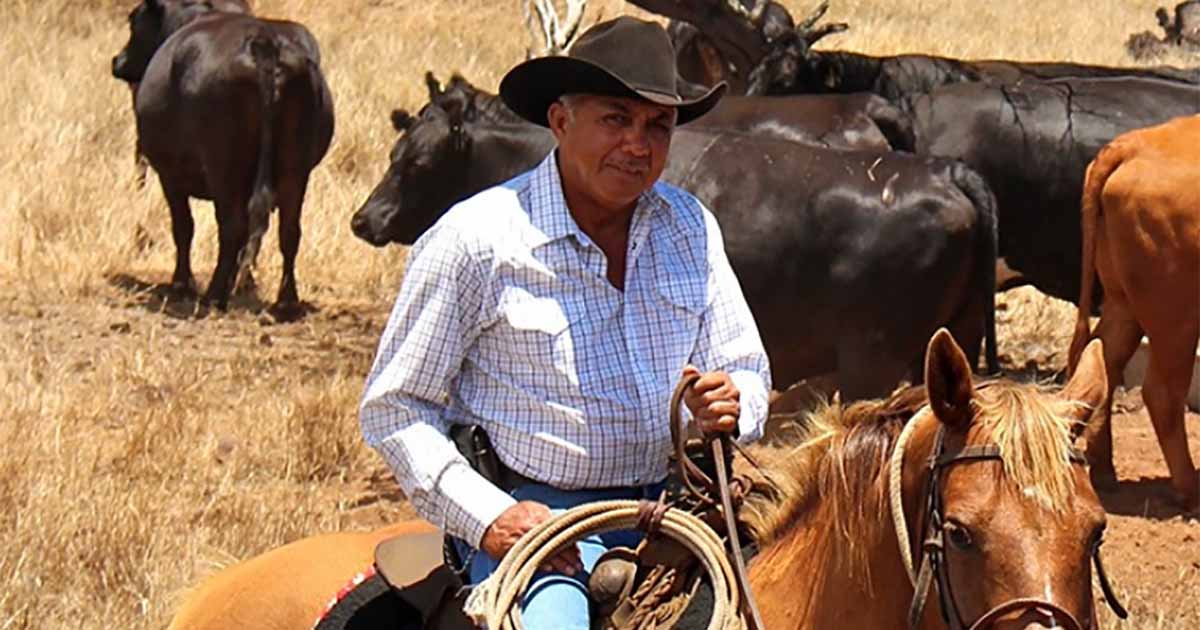
Paniolo Hall of Fame Class of 2015
In 1832, Godfrey Kainoa’s great-great-grandfather was one of the three original paniolo who came to Hawai‘i Island at the request of King Kamehameha III. His name was Ramon Baesa. He married Mary Kainoa Kupuna from Pololū and lived with her on their family’s ancestral lands in Kohala.
Five generations later, Godfrey—named for the radio and TV star Arthur Godfrey—came into the world, the tenth child in the family. “I’m the last,” Godfrey says in his Oral History Interview. “I’m the baby. And the only cowboy.”
Godfrey grew up on on the family’s 300-acre JK Ranch on Hawaiian Home Lands in Nienie. He also spent a lot of time on Kahuā Ranch, where his five uncles worked, as well as his father Johnny Kainoa, Sr. and grandfather Peter Kainoa, Sr. (PHOF Class of 2013). That’s how Godfrey earned the nickname Jingles as a little boy, carrying around a metal bucket of nails for the fencing crew.
“The horse was my babysitter,” he says with a laugh, relating how his dad would put little Godfrey in the saddle before he went to work in the morning. “So I just stayed on the horse. I was more afraid of my dad than the horse. And he’d come back for lunch, take me off. Feed me lunch. Take his lunch hour. After that, throw me back on the horse and he goes back to work!”
Although his three brothers left ranch life after graduation, Godfrey stayed, watching and helping his father and grandfather work hard every day. “I always wanted to be like them, you know. And I remember my dad telling me on his death bed—He didn’t want me to become a cowboy, a paniolo on the ranch—And he told me if you become a cowboy you promise me one thing. You be the best.”
In 1963, at age 8, Godfrey was a jockey for his father at the at Ho‘olulu Race Track in Hilo (where Edith Kanaka‘ole Stadium is now). He thought of Kimo Ho‘opai, Sr. as a big brother, and followed him around the ranch, “stuck to him like glue.” He got his first paying job at age 15, working alongside the cowboys, while other schoolkids had to go out with the fencing crew.
He joined the military and left home at age 18, but had only served about six months when his father passed away. Godfrey put in for a hardship discharge, came back to the island and started working for Parker Ranch in 1973. At the same time he took over the family ranch.
Parker Ranch was huge at that time, Godfrey himself taking care of over 100,000 acres. He remembers them branding 1,700 cows in one day, in about four and a half hours, 6-10:30 a.m. “Everybody comes. Like the truck drivers, the carpenters, utility gang, pipe crew, cowboys, everybody come and brand that day,” he says. “So we get like twenty ropers out there. Then branding ovens, there’s like six or seven lined up in the corral.”
“Everything was spoken in Hawaiian,” Godfrey says. “There’s one man, he stands by the gate that the cows run through and then, he go yell’um all in Hawaiian. You better know what he’s talking about!” As the man shouted “Kane!” or “Wahine!” or the color of the cow, the cowboys took care of business. “It’s a full day’s work,” Godfrey says. “And the last job we do at the end of the day, we put the cows away and then the so-called dry cows that we pull out of the herd, we lock them up separate. And then all the calves, we got to count these calves. I mean that takes about two hours to count.” Of course the day ended with a big party, Hawaiian music and food, including kalua pig from the imu.
At Parker he worked with PHOF members like Jiro Yamaguchi (Class of 2002) and Walter “Wala” Stevens (Class of 2013). Stevens gave him the opportunity to work as a horse trainer, and he became very skilled, with a string of some 30 working horses. Godfrey was also something of a rodeo star, frequently winning bull and bronc riding events at the July 4th Rodeo and others.
He fondly remembers how well sixth-generation Parker heir Richard Smart took care of the ranch family, helping with bills, medical expenses, etc. “He’d say ‘Pay me back if you can. If not don’t worry about it,’” Godfrey says.
Richard had built the Parker Ranch Broiler in the 1970’s as a place for his workers to enjoy their pau hana. When a couple of new East Coast managers came in, they made the mistake of asking some dusty cowboys to leave because they were still in their work clothes. “Richard Smart heard about it,” Godfrey says with a laugh. “Man, he fired the two guys, and he sent them back to Boston. He said, ‘You don’t throw my cowboys out of the bar. I built that bar for them.’”
In 2002, Godfrey went back to Kahuā Ranch, while continuing to work his own place. When he considers his long career, it is not without pride and satisfaction. He says, “If I had to do it all over again, I’d do it again. Yeah, yeah, yeah. Has to be yeah. A lot of rough years I lived. I’d do it again… Mālama the ʻāina. mālama the pipi. That’s what I was taught to do, you know.”
